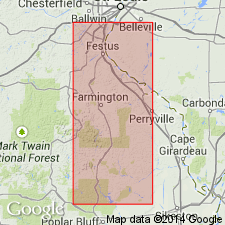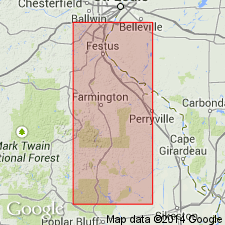
- Usage in publication:
-
- Shepherd Mountain Rhyolite
- Modifications:
-
- Named
- Dominant lithology:
-
- Rhyolite
- Tuff
- AAPG geologic province:
-
- Midcontinent region
Summary:
Shepherd Mountain Rhyolite. Unit is part of sequence of Precambrian volcanic rocks associated with Taum Sauk caldera in western part of St. Francois Mountains, southeast Missouri (Midcontinent region). Notable exposures on Shepherd Mountain and Pond Ridge, Iron County, Missouri. Consists of brick-red to dark-maroon ash-flow tuff with white to slightly pink plagioclase phenocrysts and many fiamme; generally has well-developed snowflake texture. Thickness 600 m. Overlies Cedar Bluff Rhyolite (new). Age is Precambrian. Is oldest of Precambrian volcanic rocks in study area. Report includes geologic map. Unit named and described on stratigraphic column (table 1).
Russell Mountain Rhyolite replaces: Pilot Knob Felsite (Shepherd Mountain) and Stouts Creek Rhyolite (Pond Ridge) as mapped by Tolman and Robertson (1969, Missouri Geol. Survey Rpt. Inv., no. 44); lower undifferentiated felsite of Anderson (1970, Missouri Geol. Survey Rpt. Inv., no. 46); and Unit 700 of Berry and Bickford (1972, Bull. Volcanology, v. 36, p. 303-318).
Type section: in sec. 31, T. 34 N., R. 4 E., Ironton quadrangle, Iron Co., MO. Named from exposures on Shepherd Mountain, northwest of Ironton, Iron Co., MO.
Source: Modified from GNU records (USGS DDS-6; Denver GNULEX).

- Usage in publication:
-
- Shepherd Mountain Rhyolite
- Modifications:
-
- Revised
- AAPG geologic province:
-
- Midcontinent region
Summary:
Shepherd Mountain Rhyolite, basal formation (of 12) of /Taum Sauk Group (new) of /St. Francois Mountains Volcanic Supergroup (revised). Study area is St. Francois Mountains, southeast Missouri (Midcontinent region). Overlies Pilot Knob Felsite (revised) of /Butler Hill Group of St. Francois Mountains Volcanic Supergroup; underlies Cedar Bluff Rhyolite (revised) of Taum Sauk. Age is Precambrian Y. Nomenclature listed in table 1.
[Conflicts with nomenclature guidelines (ACSN, 1970; NACSN, 1983, 2005, 2021): name Taum Sauk used for both group and formation within it (Taum Sauk Rhyolite has priority); name St. Francois Mountains applied concurrently to two different units in same area; a [supergroup] name combines a geographic name with the term ["supergroup,"] and no lithic designation is included; name Butler Hill applied concurrently to two different units in same area; preempted by Butler Hill Granite of Tolman and Robertson (1969).]
Source: Modified from GNU records (USGS DDS-6; Denver GNULEX).
For more information, please contact Nancy Stamm, Geologic Names Committee Secretary.
Asterisk (*) indicates published by U.S. Geological Survey authors.
"No current usage" (†) implies that a name has been abandoned or has fallen into disuse. Former usage and, if known, replacement name given in parentheses ( ).
Slash (/) indicates name conflicts with nomenclatural guidelines (CSN, 1933; ACSN, 1961, 1970; NACSN, 1983, 2005, 2021). May be explained within brackets ([ ]).

